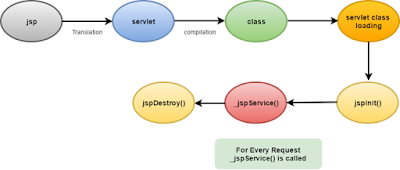JSP Lifecycle
The lifecycle of a JSP is the entire process from
its creation till the destruction which is similar to a servlet life cycle with
an additional step, which translates the JSP into a Servlet.
Following are the JSP Lifecycle phases.
1.
Translation
of JSP to Servlet code.
2.
Compilation
of Servlet to bytecode.
3.
Loading
Servlet class.
4.
Creating
servlet instance.
5.
Initialization
by calling jspInit() method
6.
Request
Processing by calling _jspService() method
7.
Destroying
by calling jspDestroy() method
 |
JSP Lifecycle
|
JSP Translation and Compilation
When
a user request for a JSP, the JSP engine first checks to see whether it needs
to compile the page. If the page has never been compiled, or if the JSP has
been modified since it was last compiled, the JSP engine does the following
1.
Parse the JSP
2.
Transforms the
JSP to a Servlet
3.
Compile the
Servlet (.java) file to a class file.
JSP Initialization
Before
servicing any request the web container loads the JSP and invokes jspInit()
method. Initialization is performed only once, just as with servlets init()
method. If you need to perform any JSP-specific initialization, you need yo override
the jspInit() method.
JSP Service
Once the JSP page
has been loaded and initialized, the JSP engine invokes
the _jspService() method in the JSP.
The _jspService()
method takes an HttpServletRequest and an HttpServletResponse as
its parameters.
The _jspService()
method of a JSP is invoked once per request and is responsible for generating
the response for that request.
JSP Destruction
The destruction
phase of the JSP life cycle represents when a JSP is being removed from use by
a container.
The jspDestroy() method
is the JSP similar to the destroy method for servlets. We need to Override
jspDestroy() method when we need to perform any cleanup operation, such as
releasing database connections or closing files which were opened.